The Intel 6th Gen Skylake Review: Core i7-6700K and i5-6600K Tested
by Ian Cutress on August 5, 2015 8:00 AM ESTWhat You Can Buy: Gaming Benchmarks on the High End
Alien: Isolation
If first person survival mixed with horror is your sort of thing, then Alien: Isolation, based off of the Alien franchise, should be an interesting title. Developed by The Creative Assembly and released in October 2014, Alien: Isolation has won numerous awards from Game Of The Year to several top 10s/25s and Best Horror titles, ratcheting up over a million sales by February 2015. Alien: Isolation uses a custom built engine which includes dynamic sound effects and should be fully multi-core enabled.
For low end graphics, we test at 720p with Ultra settings, whereas for mid and high range graphics we bump this up to 1080p, taking the average frame rate as our marker with a scripted version of the built-in benchmark.
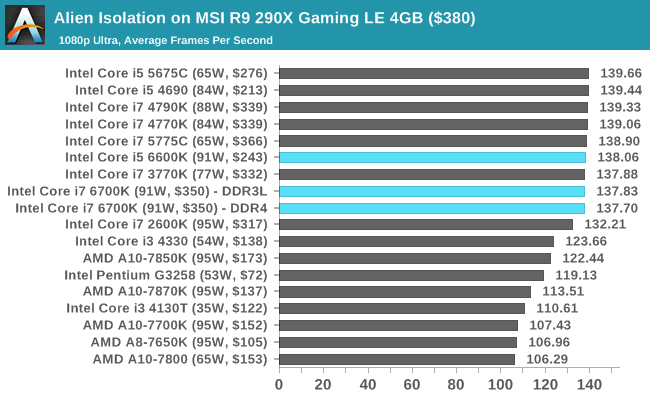
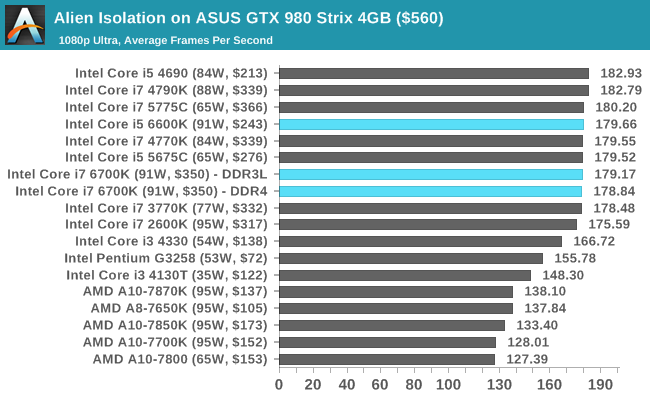
Total War: Attila
The Total War franchise moves on to Attila, another The Creative Assembly development, and is a stand-alone strategy title set in 395AD where the main story line lets the gamer take control of the leader of the Huns in order to conquer parts of the world. Graphically the game can render hundreds/thousands of units on screen at once, all with their individual actions and can put some of the big cards to task.
For low end graphics, we test at 720p with performance settings, recording the average frame rate. With mid and high range graphics, we test at 1080p with the quality setting. In both circumstances, unlimited video memory is enabled and the in-game scripted benchmark is used.
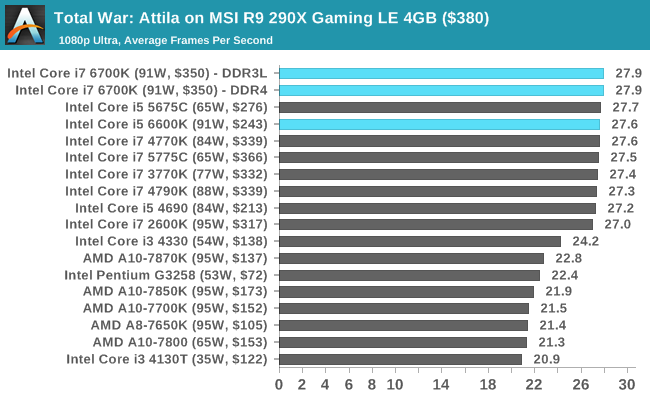
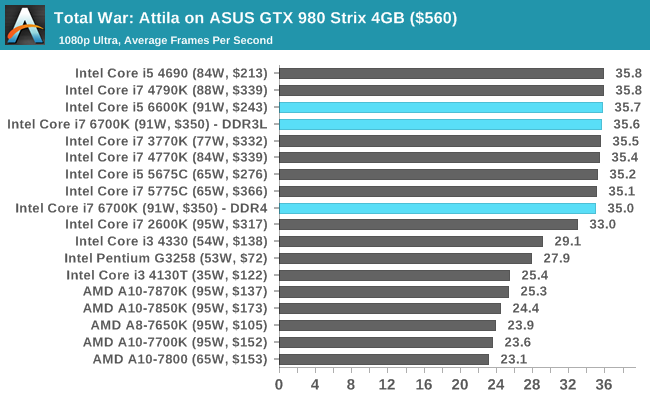
Grand Theft Auto V
The highly anticipated iteration of the Grand Theft Auto franchise finally hit the shelves on April 14th 2015, with both AMD and NVIDIA in tow to help optimize the title. GTA doesn’t provide graphical presets, but opens up the options to users and extends the boundaries by pushing even the hardest systems to the limit using Rockstar’s Advanced Game Engine. Whether the user is flying high in the mountains with long draw distances or dealing with assorted trash in the city, when cranked up to maximum it creates stunning visuals but hard work for both the CPU and the GPU.
For our test we have scripted a version of the in-game benchmark, relying only on the final part which combines a flight scene along with an in-city drive-by followed by a tanker explosion. For low end systems we test at 720p on the lowest settings, whereas mid and high end graphics play at 1080p with very high settings across the board. We record both the average frame rate and the percentage of frames under 60 FPS (16.6ms).
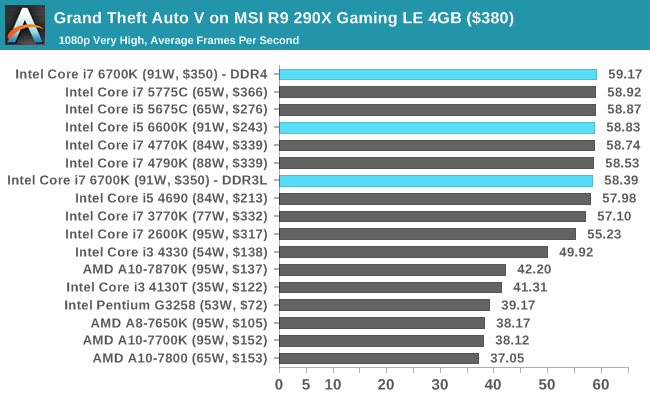
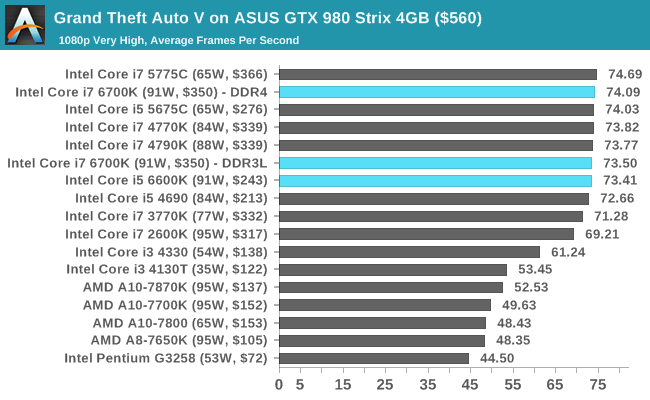
GRID: Autosport
No graphics tests are complete without some input from Codemasters and the EGO engine, which means for this round of testing we point towards GRID: Autosport, the next iteration in the GRID and racing genre. As with our previous racing testing, each update to the engine aims to add in effects, reflections, detail and realism, with Codemasters making ‘authenticity’ a main focal point for this version.
GRID’s benchmark mode is very flexible, and as a result we created a test race using a shortened version of the Red Bull Ring with twelve cars doing two laps. The car is focus starts last and is quite fast, but usually finishes second or third. For low end graphics we test at 1080p medium settings, whereas mid and high end graphics get the full 1080p maximum. Both the average and minimum frame rates are recorded.
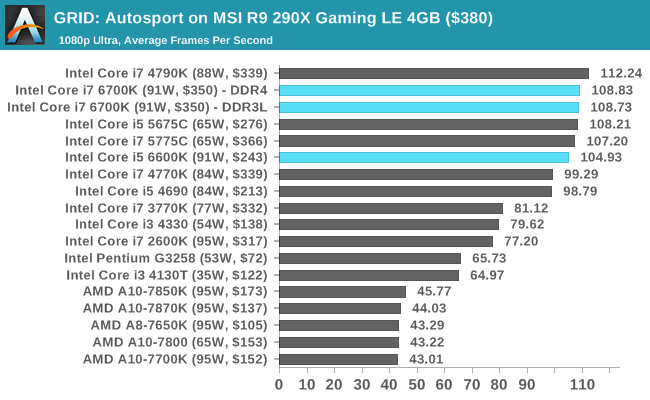
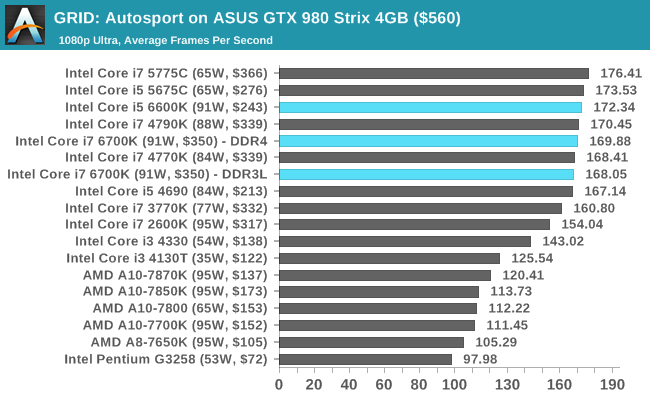
Middle-Earth: Shadow of Mordor
The final title in our testing is another battle of system performance with the open world action-adventure title, Shadow of Mordor. Produced by Monolith using the LithTech Jupiter EX engine and numerous detail add-ons, SoM goes for detail and complexity to a large extent, despite having to be cut down from the original plans. The main story itself was written by the same writer as Red Dead Redemption, and it received Zero Punctuation’s Game of The Year in 2014.
For testing purposes, SoM gives a dynamic screen resolution setting, allowing us to render at high resolutions that are then scaled down to the monitor. As a result, we get several tests using the in-game benchmark. For low end graphics we examine at 720p with low settings, whereas mid and high end graphics get 1080p Ultra. The top graphics test is also redone at 3840x2160, also with Ultra settings, and we also test two cards at 4K where possible.
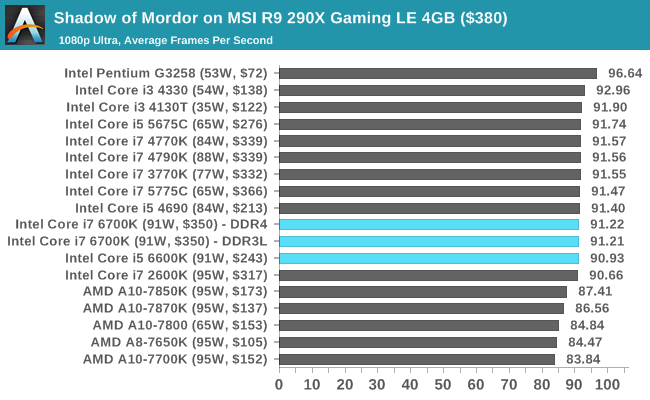


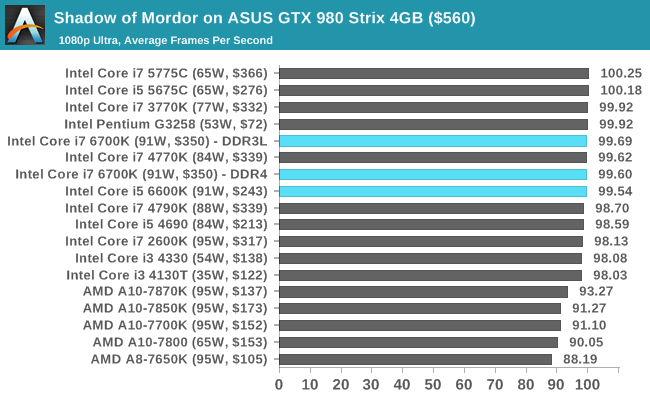
















477 Comments
View All Comments
watzupken - Friday, September 4, 2015 - link
To be honest, I feel the recent AMD chips are not so bad. From my opinion it boils down to 2 things,1) They are not able to get software makers to optimize for their chips,
2) Disadvantage in terms of fab, i.e. 28nm vs 20/14nm.
Of course, they also don't have a pocket a deep as Intel to begin with. So any misstep can have a serious setback for them.
i_will_eat_you - Saturday, December 12, 2015 - link
AMD is long dead especially for the desktop market and server market. For their latest highend chips they simply slap bigger and bigger fans/heat sinks on to deal with a higher TDP from a ramped up clock. I'm not even sure if they have a particularly good standing in the "APU" market, low end market, etc. ARM and Intel are doing much better.They only have a slight gain in the GPU market with the push of HBM but even this does not give them a strong lead and they are falling onto Apple like marketing in attempt to boast their sales.
The only reason people might tolerate AMD at the moment is because a lot of tasks will run ok on a CPU that is not the best or not the best value for money.
Until they release a new architecture and a new fabrication process they are becoming completely out of the game. I agree they have no room for error in that.
Synomenon - Monday, August 24, 2015 - link
So it's possible to have the full 16 PCIe 3.0 lanes from the CPU going to the GPU and have 4 PCIe 3.0 lanes from the chipset going to the m.2 drive on a Z170 board?wyssin - Sunday, August 30, 2015 - link
Here's what I'm talking about.In their i7-6700K review article, bit-tech.net compared chips at stock settings AND at a decent overclock. By seeing both of those results, you can see whether an upgrade makes sense for your needs (assuming you are an overclocker).
http://www.bit-tech.net/hardware/2015/08/05/intel-...
oranos - Tuesday, September 15, 2015 - link
Looks like after 5 years, there is still no reason to upgrade a 2500k.sheeple - Thursday, October 15, 2015 - link
I TOTALLY agree with yousheeple - Thursday, October 15, 2015 - link
THIS is funny, I'm using a SUPER OOOOOOLD L5408 Xeon that sips 40 watts and gives the performance of a 4th. gen i3 and runs ALL the latest 2015 games and the L5408 cost me 40 bucks on ebay, HAHAHAHAHAAAAA!!!!sheeple - Thursday, October 15, 2015 - link
My L5408 isn't even overclocked past 2.76 Ghz and runs The Witcher 3 Wild Hunt (game from 2015 on a machine with a cpu and mobo that together cost me 70 bucks used-the cpu was introduced in beginning of 2008) at 30 fps AVERAGE WITH ALL SETTINGS MAXED @ 1080p using a STOCK GTX 950 LOL!!! Whoever buys one of these "Skynet" Cpu's needs to do more research, SERIOUSLY !!!!sheeple - Thursday, October 15, 2015 - link
DON'T BE STUPID SHEEPLE!!! NEW DOES NOT ALWAYS = BETTER!manolaren - Saturday, October 31, 2015 - link
So if Anandtech tests are accurate, between the skylake cpu's, i5 is the way for a gaming pc. Gaming benchmarks are almost identical, but the price is a lot cheaper for the i5. Considering skylake doesn't bring nothing groundbreaking for the genre, then i cant see any other way for gamer's. My only question is if future games will take advantage of more than 4 cores and make i7 cpu's a must.